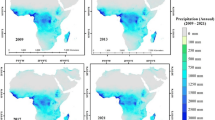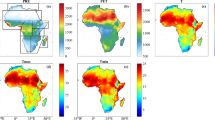Abstract
Determining whether air temperatures recorded at meteorological stations have been contaminated by the urbanization process is still a controversial issue at the global scale. With support of historical remote sensing data, this study examined the impacts of urban expansion on the trends of air temperature at 69 meteorological stations in Beijing, Tianjin, and Hebei Province over the last three decades. There were significant positive relations between the two factors at all stations. Stronger warming was detected at the meteorological stations that experienced greater urbanization, i.e., those with a higher urbanization rate. While the total urban area affects the absolute temperature values, the change of the urban area (urbanization rate) likely affects the temperature trend. Increases of approximately 10% in urban area around the meteorological stations likely contributed to the 0.13°C rise in air temperature records in addition to regional climate warming. This study also provides a new approach to selecting reference stations based on remotely sensed urban fractions. Generally, the urbanization-induced warming contributed to approximately 44.1% of the overall warming trends in the plain region of study area during the past 30 years, and the regional climate warming was 0.30°C (10 yr)−1 in the last three decades.
Similar content being viewed by others
References
Balling, R. C., and S. B. Idso, 1989: Historical temperature trends in the United-States and the effect of urban-population growth. J. Geophys. Res., 94(D3), 3359–3363.
Changnon, S. A., 1992: Inadvertent weather-modification in urban areas—Lessons for global climate change. Bull. Amer. Meteor. Soc., 73(5), 619–627.
Cheng, S. L., 2005: Urbanization effect on air temperature change in Lanzhou city for recent 60 years. Meteorological Monthly, 31, 29–34. (in Chinese)
Chu, Z., and G. Ren, 2005: Change in urban heat island magnitude and its effect on mean air temperature record in Beijing region. Acta Meteorologica Sinica, 63(4), 534–540. (in Chinese)
Englehart, P. J., and A. V. Douglas, 2003: Urbanization and seasonal temperature trends: Observational evidence from a data-sparse part of North America. Int. J. Climatol., 23(10), 1253–1263.
Friedl, M. A., and C. E. Brodley, 1997: Decision tree classification of land cover from remotely sensed data. Remote Sens. Environ., 61. 399–409.
Gallo, K. P., A. L. Mcnab, T. R. Karl, J. F. Brown, and J. J. Hood, 1993: The use of noaa avhrr data for assessment of the urban heat-island effect. J. Appl. Meteor., 32(5), 899–908.
Gallo, K. P., J. D. Tarpley, A. L. McNab, and T. R. Karl, 1995: Assessment of urban heat islands—A satellite perspective. Atmospheric Research, 37(1–3), 37–43.
Gallo, K. P., D. R. Easterling, and T. C. Peterson, 1996: The influence of land use land cover on climatological values of the diurnal temperature range. J. Climate, 9(11), 2941–2944.
Golitsyn, G. S., Kadygrov, E. N., and Kuznetsova, I. N., 2002: Microwave remote investigation of the atmospheric boundary layer thermal regime above an urban area. Proc. Twelfth Atmospheric Radiation Measurement (ARM) Science Team Meeting. St. Petersburg, Florida, 7pp.
Hansen, J., R. Ruedy, M. Sato, M. Imhoff, W. Lawrence, D. Easterling, T. Peterson, and T. Karl, 2001: A closer look at United States and global surface temperature change. J. Geophys. Res., 106(D20), 23947–23963.
Hua, L. J., Z. G. Ma, and W. D. Guo, 2007: The impact of urbanization on air temperature across China. Theor. Appl. Climatol., 93(3–4), 179–194.
Hughes, W. S., and R. C. Balling, 1996: Urban influences on south African temperature trends. Int. J. Climatol., 16(8), 935–940.
Ji, C. P, W. D. Liu, and C. Y. Xuan, 2006: Impact of urban growth on the heat island in Beijing. Chinese J. Geophys., 49(1), 69–77. (in Chinese)
Jones, P. D., 1990: Assessment of urbanization effects in time series of surface air temperature over land. Nature, 347, 169–172.
Jones, P. D., D. H. Lister, and Q. Li, 2008: Urbanization effects in large-scale temperature records, with an emphasis on China. J. Geophys. Res., 113(D16), doi: 10.1029/2008JD009916.
Kalnay, E., and M. Cai, 2003: Impact of urbanization and land-use change on climate. Nature, 423(6939), 528–531.
Karl, T. R., H. F. Diaz, and G. Kukla, 1988: Urbanization: Its detection and effect in the United States climate record. J. Climate, 1, 1099–1123.
Khaikine, M. N., I. N. Kuznetsova, E. N. Kadygrov, E. A. Miller, 2006: Investigation of temporal-spatial parameters of an urban heat island on the basis of passive microwave remote sensing. Theor. Appl. Climatol., 84(1–3), 161–169.
Kukla, G., J. Gavin, and T. R. Karl, 1986: Urban warming. J. Climate Appl. Meteor., 25(9), 1265–1270.
Landsberg, H., 1956: The climate of towns. Man’s Role in Changing the Face of the Earth. W. L. Thomas Jr., Ed., The University of Chicago Press, 584–603.
Landsberg, H., 1981: The Urban Climate. Academic Press, 275pp.
Li, Q., H. Zhang, X. Liu, and J. Huang, 2004: Urban heat island effect on annual mean temperature during the last 50 years in China. Theor. Appl. Climatol. 79(3–4), 165–174.
Li, Q., W. Li, P. Si, X. Gao, W. Dong, P. Jones, J. Huang, and L. Cao, 2010: Assessment of surface air warming in north-east China, with emphasis on the impacts of urbanization. Theor. Appl. Climatol., 99(3–4), 469–478.
Lin, X. C., and S. Q. Yu, 2005: Interdecadal changes of temperature in the Beijing region and its heat island effect. Chinese J. Geophysics, 48(1), 39–45.
Liu, X. F., C. W. Yu, and G. Y. Ren, 2005: Change in urban heat island magnitude and its effect on surface mean air temperature record in Hebei Province, China. Climate and Environment Research, 10(4), 763–770. (in Chinese)
McKitrick, R. R., and P. J. Michaels, 2007: Quantifying the influence of anthropogenic surface processes and inhomogeneities on gridded global climate data. J. Geophys. Res., 112(D24), doi: 10.1029/2007JD008465.
Offerle, B., P. Jonsson, I. Eliasson, and C. S. B Grimmond, 2005: Urban modification of the surface energy balance in the West African Sahel: Ouagadougou, Burkina Faso. J. Climate, 18(19), 3983–3995.
Oke, T. R., 1987: Boundary Layer Climates. Routledge, 435pp.
Pal, M., and P. M. Mather, 2003: An assessment of the effectiveness of decision tree methods for land cover classification. Remote Sens. Environ., 86(4), 554–565.
Parker, D., 2004: Large scale warming is not urban. Nature, 432, 290–290.
Peterson, T. C., 2003: Assessment of urban versus rural in situ surface temperatures in the contiguous United States: No difference found. J. Climate, 16(18), 2941–2959.
Peterson, T. C., K. P. Gallo, J. Lawrimore, T. W. Owen, A. Huang, and D. A. McKittrick, 1999: Global rural temperature trends. Geophys. Res. Lett., 26(3), 329–332.
Portman, D. A., 1993: Identifying and correcting urban bias in regional time series-surface temperature in China’s nothern plains. J. Climate, 6(12), 2298–2308.
Rao, P. K., 1972: Remote sensing of urban heat islands from an environmental satellite. Bull. Amer. Meteor. Soc. 53(7), 647–648.
Ren, G. Y., and Coauthors, 2005: Recent progresses in studies of regional temperature changes in China. Climate Environment Research, 10(4), 701–715. (in Chinese)
Ren, G. Y., Z. Y. Chu, Z. H. Chen, and Y. Y. Ren, 2007: Implications of temporal change in urban heat island intensity observed at Beijing and Wuhan stations. Geophys. Res. Lett., 34(5), doi: 10.1029/2006GL027927
Ren, G. Y., Y. Zhou, Z. Y. Chu, J. X. Zhou, A. Y. Zhang, J. Guo, and X. F. Liu, 2008: Urbanization effects on observed surface air temperature trends in North China. J. Climate., 21(6), 1333–1348.
Ren, Y., and G. Ren, 2011: A remote-sensing method of selecting reference stations for evaluating urbanization effect on surface air temperature trends. J. Climate, 24(13), 3179–3189.
Schmid, H. P., 1994: Source areas for scalars and scalar fluxes. Bound.-Layer Meteor., 67, 293–318.
Si, P., Q. Li, C. Xuan, and H. Yin, 2009: Contribution of urbanization to change of air temperature in Beijing. Journal of Natural Disasters, 18(4), 138–144. (in Chinese)
Wang, F., and Q. S. Ge, 2012: Estimation of urbanization bias in observed surface temperature change in China from 1980 to 2009 using satellite landuse data. Chinese Science Bulletin., 57(14), 1708–1715.
Wang, W. C., Z. M. Zeng, and T. R. Karl, 1990: Urban heat islands in China. Geophys. Res. Lett., 17(13), 2377–2380.
Weng, Q., 2009: Thermal infrared remote sensing for urban climate and environmental studies: Methods, applications, and trends. Isprs J. Photogrammetry and Remote Sensing, 64(4), 335–344.
Wu, C., D. Landgrebe, and P. Swain, 1975: The decision tree approach to classification. Rep. RE-EE 75-17, School Elec. Eng., Purdue Univ., Lafayette, IN, 172pp.
Yang, X. C., Y. L. Zhang, L. S. Liu, W. Zhang, M. J. Ding, and Z. F. Wang, 2009: Sensitivity of surface air temperature change to land use/cover types in China. Sci. China (D), 52(8), 1207–1215.
Zhang, J. Y., W. J. Dong, L. Y. Wu, J. F. Wei, P. Y. Chen, and D. K. Lee, 2005: Impact of land use changes on surface warming in China. Adv. Atmos. Sci., 22(3), 343–348.
Zhang, A. Y., G. Y. Ren, J. X. Zhou, Z. Y. Chu, Y. Y. Ren, and G. L. Tang, 2010: On the urbanization effect on surface air temperature trends over China. Acta Meteologica Sinica, 68(6), 957–966. (in Chinese)
Zheng, Z. F., Y. Zheng, and Q. C. Li, 2006: Effect of urbanization on the temperature of Beijing metropolis in recent 30 years. Chinese Journal of Eco-Agriculture, 15(04), 26–29. (in Chinese)
Zhou, Y. Q., and G. Y. Ren, 2005: Identifying and correcting urban bias for regional surface air temperature series of North China over period of 1961-2000. Clim. Environ. Res., 10(4), 743–753.
Author information
Authors and Affiliations
Corresponding author
Rights and permissions
About this article
Cite this article
He, Y., Jia, G., Hu, Y. et al. Detecting urban warming signals in climate records. Adv. Atmos. Sci. 30, 1143–1153 (2013). https://doi.org/10.1007/s00376-012-2135-3
Received:
Revised:
Accepted:
Published:
Issue Date:
DOI: https://doi.org/10.1007/s00376-012-2135-3




